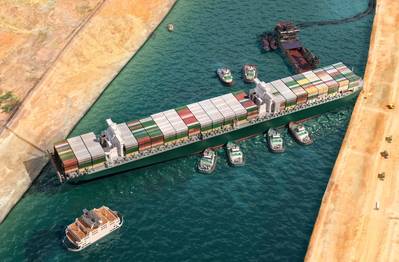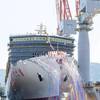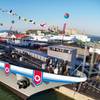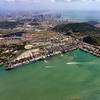Ever Given: “The Captain Has Command of the Ship at All Times”
The Panama Maritime Authority has submitted its accident investigation report on the Ever Given to the IMO which includes the conclusion that “the Captain has command of the ship at all times.”
On 23 March 2021, the Suez Canal was blocked for six days after the grounding of Ever Given between March 23 and March 29, 2021. The 20,000 TEU container vessel was struck by strong winds and ended up wedged across the waterway with its bow and stern stuck in the canal banks, blocking all traffic until it could be freed.
A critical time period in the incident occurred at about 07:38 HRS / LT. The report states: “The helmsman reported that the vessel had stopped turning to port and was starting to turn to starboard. At the time, the vessel was close to the port bank of the canal and the speed had increased to about 13 knots over the ground. The vessel then started to turn quickly to starboard, away from the port bank. The pilot initially ordered the rudder to port 20 degrees and then hard to port to stop the vessel from turning. Then the second pilot started communicates with the first pilot in local language.
“The first pilot reduced speed to half ahead and the vessel continued to turn to starboard. There was another communication between the two pilots in Arabic language and the main engine was increased to full ahead again. The vessel continued to turn starboard, towards the starboard canal bank. The pilot again ordered hard to port presumably to try to steady the heading but vessel continued turning to starboard side. The main engine revolutions were increased to Nav full ahead (53 RPM) but still the vessel was swinging heavily starboard. The vessel continued this swing and grounded at a speed of about 12 knots over the ground on the eastern bank of the canal at 07:41 HRS / LT, at location 30 01.059N / 032 34.810E, at 151 KM of Suez Canal.”
The investigators concluded that, according to Suez Canal regulations, the Captain has command of the ship at all times, and the pilot or pilots only fulfill an advisory role.
The report goes on to say that the Pilots conducted the pilotage without requesting assistance from the Captain, who was more familiar with vessel maneuvering characteristics. Although the Captain did intervene in the orders given by the pilot, instructing the helmsman to keep the ship in the middle of the channel, they were not effective in preventing the grounding.
According to the Suez Canal regulations, the permissible speed for ships is 8.64 knots, on average the Ever Given sailed at a speed higher than the permissible.
The bridge team did not realize the vital importance of effective/efficient communication between the bridge crew and Pilots. Discussions between the Pilots in Arabic did not allow for the bridge team to assess potential hazards, conduct a risk assessment, implement corrective actions, or even request assistance from the VTMS.
The VTMS, Pilots and Captain had not properly evaluated bad weather conditions, especially strong winds and reduced visibility, as a risk condition for a vessel with a large area exposed to the wind. The vessel did not implement preventive measures against the bad weather conditions by engaging tug assistance as indicated in the Suez Canal rules.
The report describes recommended preventative measures for crews:
1. It is recommended that prior to any transit in the Suez Canal the Captain should gather deck/engine officers to demonstrate and explain proper marine practice to enhance teamwork, consensus and safety awareness.
2. It is recommended that in the familiarization meeting the pilot and the Captain establish the language in which communications will be carried out, preferably English which is the commonly accepted language for onboard communications.
3. It is recommended that the bridge team members are not over-confident about the Pilot's abilities and skills. In some situations, the Pilot may not be familiar with the particular design of the vessel and maneuvering characteristics, which could lead to undesirable circumstances. Therefore, the Captain must intervene if they consider it necessary, since according to the regulation of the Suez Canal, the role of the pilot is that of an adviser.
4. It is recommended that the bridge team should monitor the Pilot’s orders and ensure that all actions taken are timely, efficient, and effective. Additionally, the bridge team should try as much as possible and always take into consideration the pilot’s advice, to follow the passage plan, which has been properly designed, thorough checks, and can provide valuable information, such as abort points, safe transit speed, wheel over position, no go areas, contingency plans, etc.
5. It is recommended that vessels proceed with utmost attention when approaching a significant turn and give attention to safe speed. The vessel should be positioned at the center of the canal. This way, any potential bank effect will be reduced to a minimum, the vessel will be able to turn smoothly and there will be extra time to react in case of a navigational error. The rate of turn should never be greater than 10°/min.












